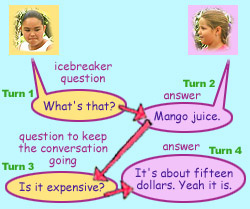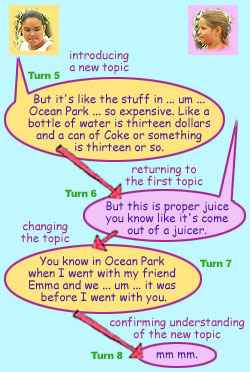Communicative functions: Interacting with others
| Using formulaic expressions |
Keeping a conversation going (turn-taking, introducing and changing topics)
Once the conversation has started we keep it going by taking turns. As we take turns we use a range of formulaic expressions. One of the most common ways to take a turn is to ask a question. When one speaker asks a question in a conversation, another speaker usually gives an answer.
Here is an example from a children's conversation. The first speaker breaks the ice with a question in TURN 1. The second speaker's answer introduces the topic mango juice in TURN 2. Then, in TURN 3, the first speaker asks a question about the mango juice:

The topic of the first four turns is mango juice. After that the speakers change the topic of the conversation to the new ride
at Ocean Park. They use several formulaic expressions to help them do this. In TURN
5 the first speaker uses the expression it's like ... to compare the
expensive mango juice with the expensive drinks at Ocean Park. In this way she introduces
the topic Ocean Park into the conversation. In TURN
6 the second
speaker returns to the topic of mango juice. But the first speaker wants
to talk about Ocean Park so she changes the topic in TURN
7. The speaker
says you know in Ocean Park to signal that the subject has changed. In TURN
8
the second speaker confirms that she understands the new topic with the expression mm mm:

Here are some expressions commonly used for signalling a topic change:
Did you know that ...
Have you heard about ...
Well ...
So ...
Here are some expressions for confirming understanding:
Oh
Yeah
Really
For more information about keeping a conversation going with turn-taking, see:
![]() Text types: Texts for social
interaction:
Overview: Keeping the interaction going
Text types: Texts for social
interaction:
Overview: Keeping the interaction going
|
||
To give us feedback about this section, click here or on the Comment button at the top of the screen.
If you have any questions about this section, visit the Language Corner.
If you have any questions or suggestions about how to teach this section, send a message to the Teaching Corner.